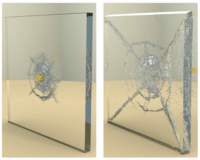Extracting Surface Geometry from Particle-Based Fracture Simulations

|
This paper describes an algorithm for fracture surface extraction from particle-based simulations of brittle fracture. We rely on a tetrahedral mesh of the rest configuration particles and use a simple, table-lookup approach to produce triangulated fracture geometry for each rest configuration tetrahedron based on its configuration of broken edges. Subsequently, these triangle vertices are transformed with a per particle transformation to obtain a fracture surface in world space that has minimal deformation and also preserves temporal coherence. The results show that our approach is effective at producing realistic fractures, and capable of extracting fracture surfaces from the complex simulation. |
[DOI/EE link]
@inproceedings{WSGL15,
address = {Las Vegas, NV},
author = {Chakrit Watcharopas and Yash Sapra and Robert Geist and Joshua A. Levine},
booktitle = {Advances in Visual Computing - 11th International Symposium, {ISVC}
2015, Proceedings, Part {I}},
day = {18},
ee = {http://dx.doi.org/10.1007/978-3-319-27857-5_8},
month = {12},
pages = {82--91},
publisher = {Springer},
series = {Lecture Notes in Computer Science},
title = {Extracting Surface Geometry from Particle-Based Fracture Simulations},
volume = {9474},
year = {2015}
}